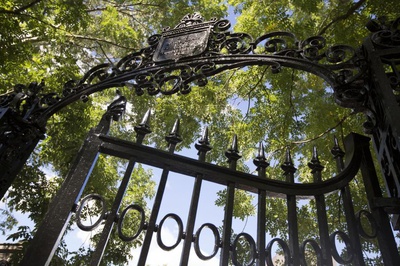
News
Nearly 200 Harvard Affiliates Rally on Widener Steps To Protest Arrest of Columbia Student

News
CPS Will Increase Staffing At Schools Receiving Kennedy-Longfellow Students

News
‘Feels Like Christmas’: Freshmen Revel in Annual Housing Day Festivities

News
Susan Wolf Delivers 2025 Mala Soloman Kamm Lecture in Ethics

News
Harvard Law School Students Pass Referendum Urging University To Divest From Israel
Harvard’s Development Can’t Leave Allstonians in the Dust
Over the last 30 years, Harvard has been the driving force behind Allston’s rising housing costs and neighborhood change. Now, it has a chance to finally begin making amends.
In the coming weeks, Harvard will finalize its Institutional Master Plan in Allston, the blueprint for the University’s development and planned benefits for neighborhood residents. Community members have laid out their requests, including additional affordable housing and support for the redevelopment of the neighborhood’s only community center.
As I’ve argued, Allston residents have long been forced to bear the costs of Harvard’s expansion, often without ever seeing the gains. To right the wrongs of past development and plan for Allstonians and Harvard affiliates alike, the University must meet community demands.
Fulfilling these asks is well within reach. Harvard should begin by accepting recommendations laid out by the Harvard Allston Task Force, a city-appointed group of Allston residents. In a recent letter, the Task Force called for the University to donate currently dormant land for affordable housing development, make a significant contribution to the Allston-Brighton Affordable Housing Fund, and support the revitalization of the Jackson Mann Community Center.
Developing affordable housing in the neighborhood requires available land, which is in short supply following Harvard’s purchases. The University owns about a third of the land and almost 40 commercial properties in the neighborhood. As of 2024, nearly a quarter lay empty.
Today, these properties represent lost opportunities for neighborhood residents. In light of the skyrocketing costs and limited supply of land in Allston, the University’s underutilized parcels should instead be donated for affordable housing construction and play a critical role in supporting community stability.
Such a move would not be unprecedented. Harvard has previously contributed two of its unused properties, 90 Antwerp Street and 65-79 Seattle Street, for affordable housing development. These donations total less than two acres — not even one percent of Harvard’s Allston holdings.
To counteract rising costs and future displacement, Harvard must dedicate more land to the development of affordable housing. While the University can afford to let its properties sit empty, Allston residents cannot.
Monetary contributions by the University can also support affordable housing preservation, as recognized in earlier community benefits agreements. In 2022, Harvard committed $25 million to establish the Allston-Brighton Affordable Housing Fund during the Enterprise Research Campus Phase A approval process.
The move was a step in the right direction. That said, the rapidly rising cost of constructing housing necessitates significant continued contributions. In Greater Boston, financing and building just one new unit can cost between $500,000 and $600,000. With such high costs, even $25 million can only go so far — 50 units at a cost of half a million per unit, to be exact.
Community benefits must not stop at affordability. Helping residents stay in their own neighborhood is the bare minimum — to ensure residents will flourish, the University must also direct investments into public community infrastructure.
Jackson Mann, the neighborhood’s only city-run community center, has been slated for demolition since 2019. And yet, delays induced by funding shortfalls have left many critical services, including after-school and preschool programming, on pause.
Contributions by Harvard to the Jackson Mann Community Center Revitalization Fund could allow the community center to once again operate as an indispensable instrument for community development and social support.
While true that Harvard’s other community programming initiatives, such as the Harvard Ed Portal, have provided meaningful arts and small business opportunities for community members, only investing in Harvard-branded projects isn’t enough. If the University is truly committed to providing sustainable social infrastructure for Allstonians, it must also invest in vital community programming operated for and by community members.
As Harvard finalizes its community benefits during the ongoing IMP process, Allston’s future hangs in the balance. Will the University take the course of minimum expenditure? Or will it commit to supporting the livelihood of its long-time neighbors?
Allston community members have made their voices heard. It’s time for Harvard to listen.
Kayla P.S. Springer ’26 is a Social Studies concentrator in Pforzheimer House.
Want to keep up with breaking news? Subscribe to our email newsletter.
Most Read
- Harvard Suspends Research Partnership With Birzeit University in the West Bank
- 2 Years After Affirmative Action Ruling, Harvard Admits Class of 2029 Without Releasing Data
- Give the Land Up — Or Shut Up
- More Than 600 Harvard Faculty Urge Governing Boards To Resist Demands From Trump
- Harvard Students Don’t Need To Work Harder. Administrators Do.
From Our Advertisers

Over 300+ courses at prestigious colleges and universities in the US and UK are at your disposal.

With innovative financial tools combined with financial education, Collegiate empowers students to take control of their finances and build confidence in their money management skills.

Serve as a proctor for Harvard Summer School (HSS) students, either in the Secondary School Program (SSP), General Program (GP), or Pre-College Program.

With an increasingly competitive Law School admissions process, it's important to understand what makes an applicant stand out.

Welcome to your one-stop gifting destination for men and women—it's like your neighborhood holiday shop, but way cooler.

Admit Expert is a premium MBA admissions consulting company, helping candidates secure admission to top B-schools across the globe with significant scholarships.

